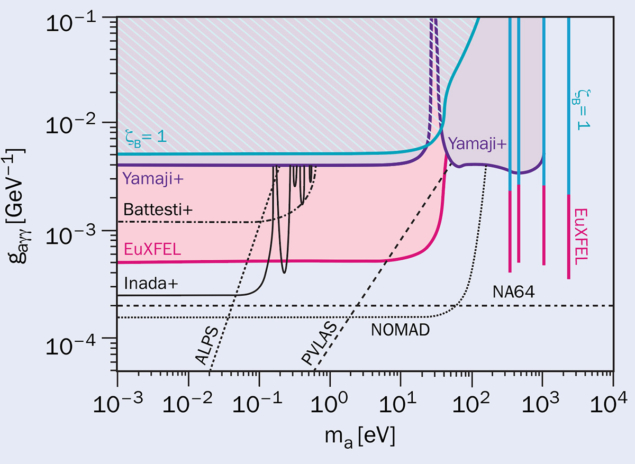
A first-of-its-kind experiment performed at the European X-Ray Free-Electron Laser (European XFEL) in Hamburg, Germany, has placed new constraints on axion-like particles in a mass range that is relatively unconstrained by laboratory searches. While similar searches have been performed at advanced storage ring-based synchrotron X-ray sources, the new study exploits the higher brightness of the European XFEL’s beams to improve the sensitivity of axion searches in the 10–3–104 eV mass range.
The axion is predicted to arise from the breaking of Peccei–Quinn symmetry, proposed in the mid-1970s to explain the observed absence of CP violation in strong interactions. Indeed, axion-like particles (ALPs) appear in any quantum field theory with a spontaneously broken global symmetry and arise naturally in many models based on string theory. They are also a promising candidate for dark matter. As such, ALPs are the target of a growing number and variety of experiments worldwide. While not yet able to reach the sensitivity of astrophysical experiments, lab-based searches are less model-dependent as they enable direct control of the axion production process.
Most laboratory searches for axions exploit the Primakoff effect: photons in the presence of a strong external electric field convert into axions, which then convert back into photons after passing through an opaque wall. This “light shining through a wall” technique has been employed in experiments with optical lasers and external magnetic fields, such as ALPS (and now ALPS II) at DESY and OSQAR at CERN. Stringent bounds on heavy axions have also been placed by the CERN Axion Solar Telescope, which looked for the conversion of photons to axions in the strong magnetic field of an LHC dipole magnet pointed at the Sun, and constraints have been set by accelerator experiments such as Belle II at KEK and NA64 at CERN.
The use of X-rays can increase the detection sensitivity by exploiting the strong electric fields (up to 1011 V m–1, which corresponds to magnetic field strengths of order 1 kT) present in crystalline materials. Gianluca Gregori of the University of Oxford and co-workers used the European XFEL’s HED/HiBEF instrument, in which axion production and photon regeneration are expected to take place via the electric field within a pair of germanium crystals. Orienting the crystals such that their lattice planes are parallel to one another leads to a coherent effect analogous to Bragg scattering, while the much shorter duration and higher brightness of photon pulses from the European XFEL compared to previous synchrotron X-ray experiments allows for a more accurate discrimination of the signal against background.
Using three days of beam time, the team was able to improve on previous lab-based searches at several discrete axion masses. For masses greater than about 200 eV, the team claims to have surpassed the sensitivity of bounds from all previous searches for lab-generated axions except those at NA64. Further improvements in sensitivity – for example by enabling a higher X-ray flux and bunch-number, and by cooling the first crystal to extend the data-acquisition time – are possible, says the team, perhaps bringing the estimated bounds close to the expectation for QCD axions to be dark matter.
“This study shows the power of XFELs, alongside their principal role in more applied domains, to probe fundamental physics mysteries,” says Gregori. “This experiment required a difficult interpretation of a non-standard measurement, and it is hoped that further work will improve on these first limits.”
Further reading
J W D Halliday et al. 2024 arXiv:2404.17333.







